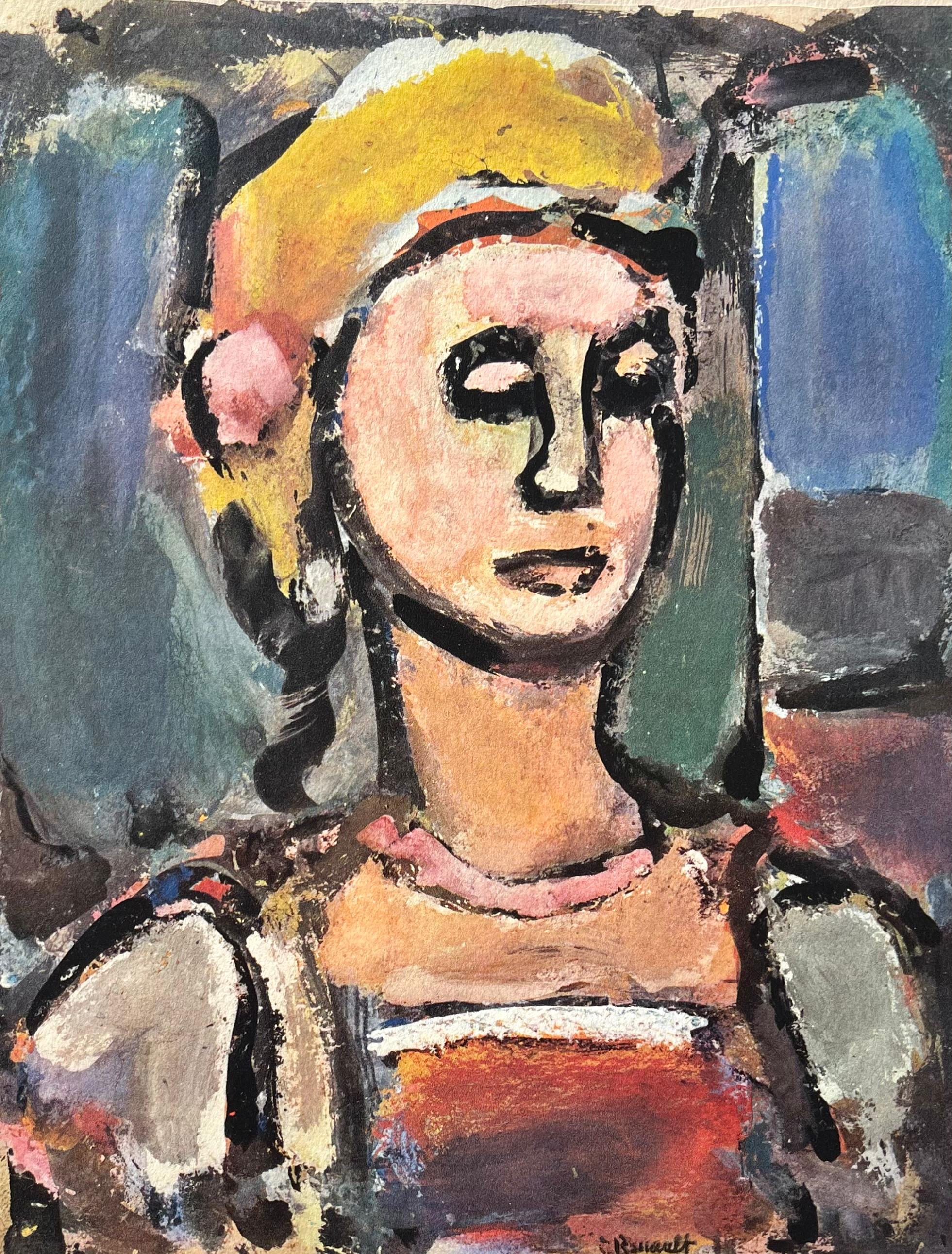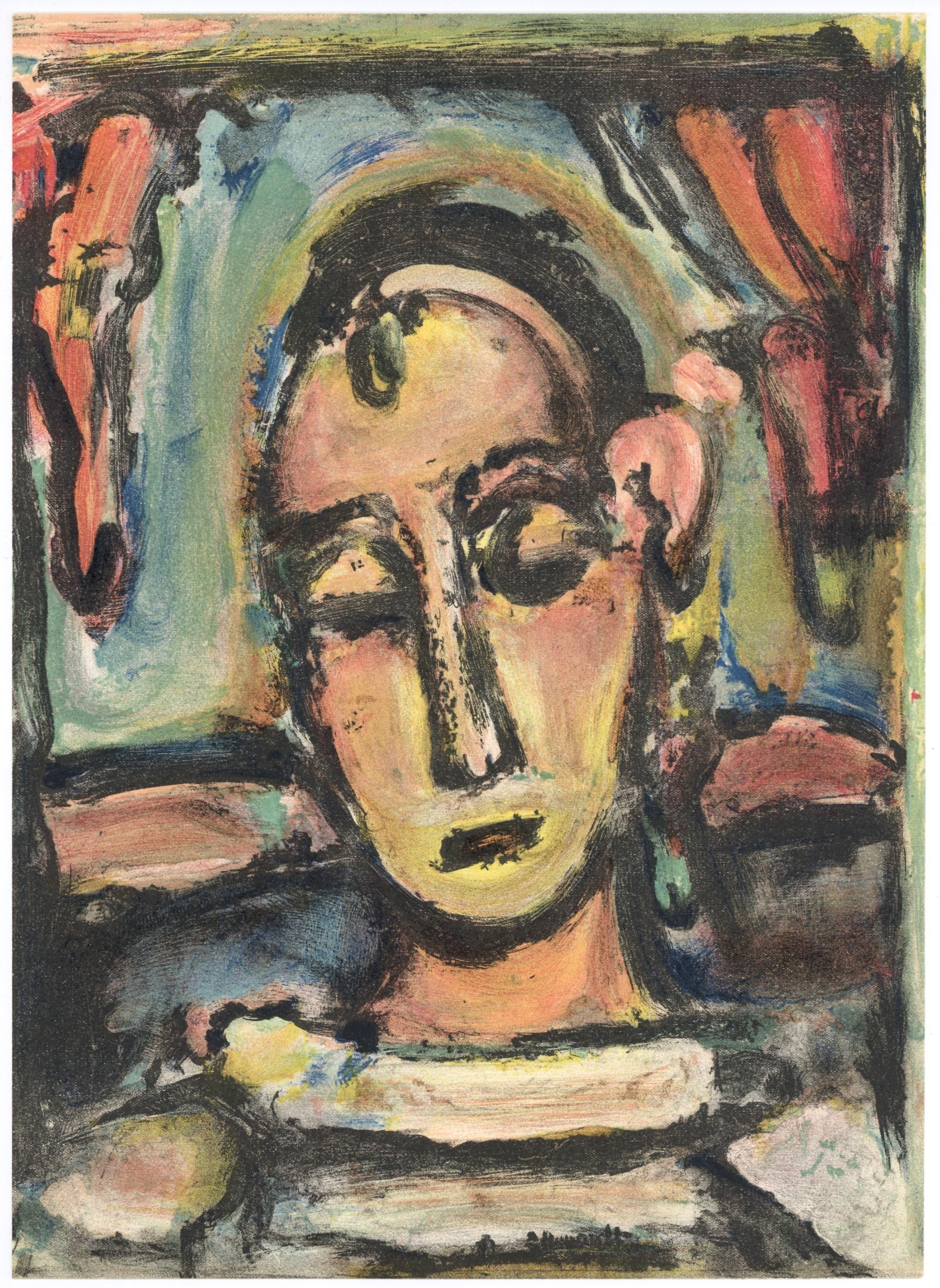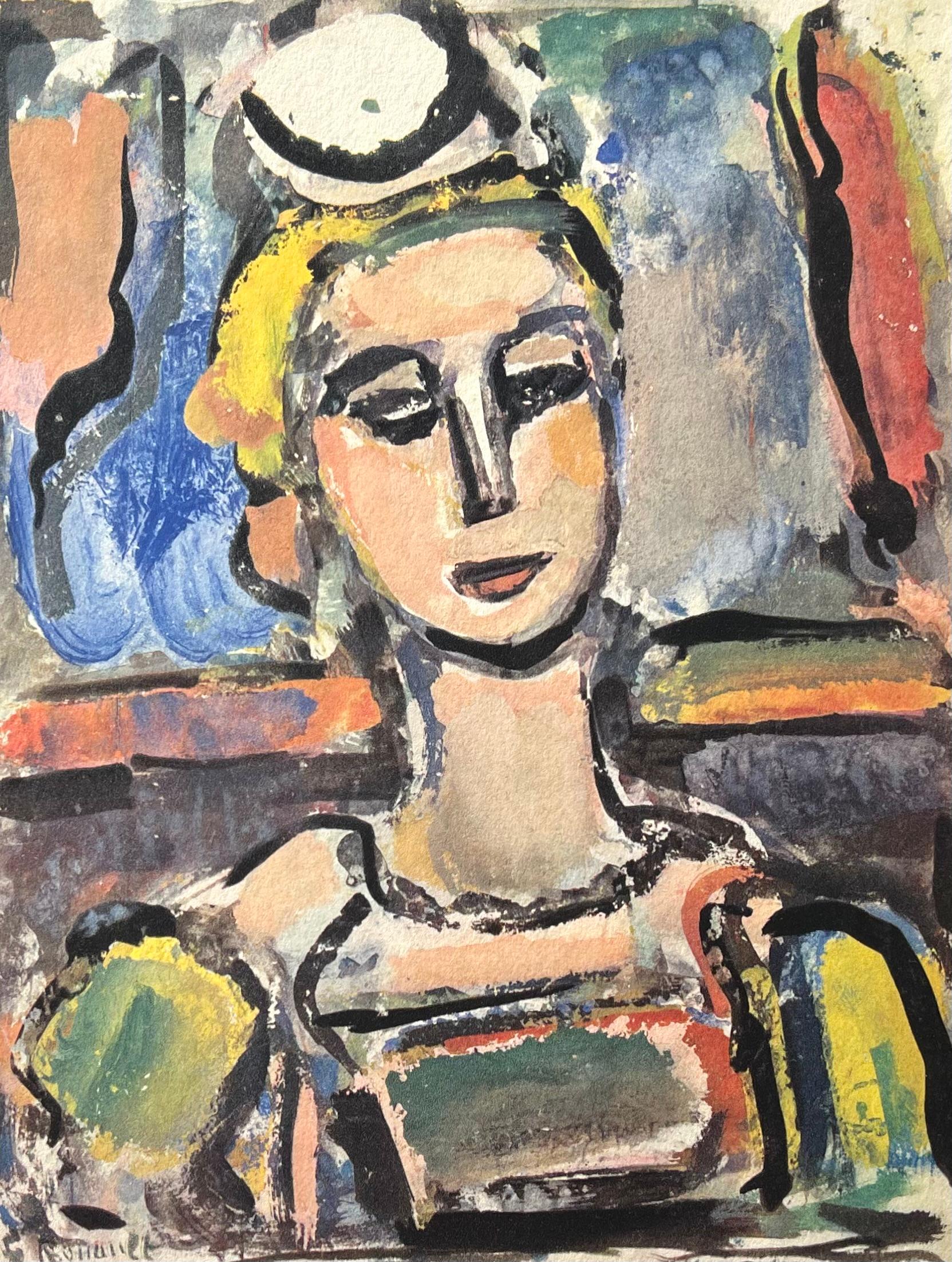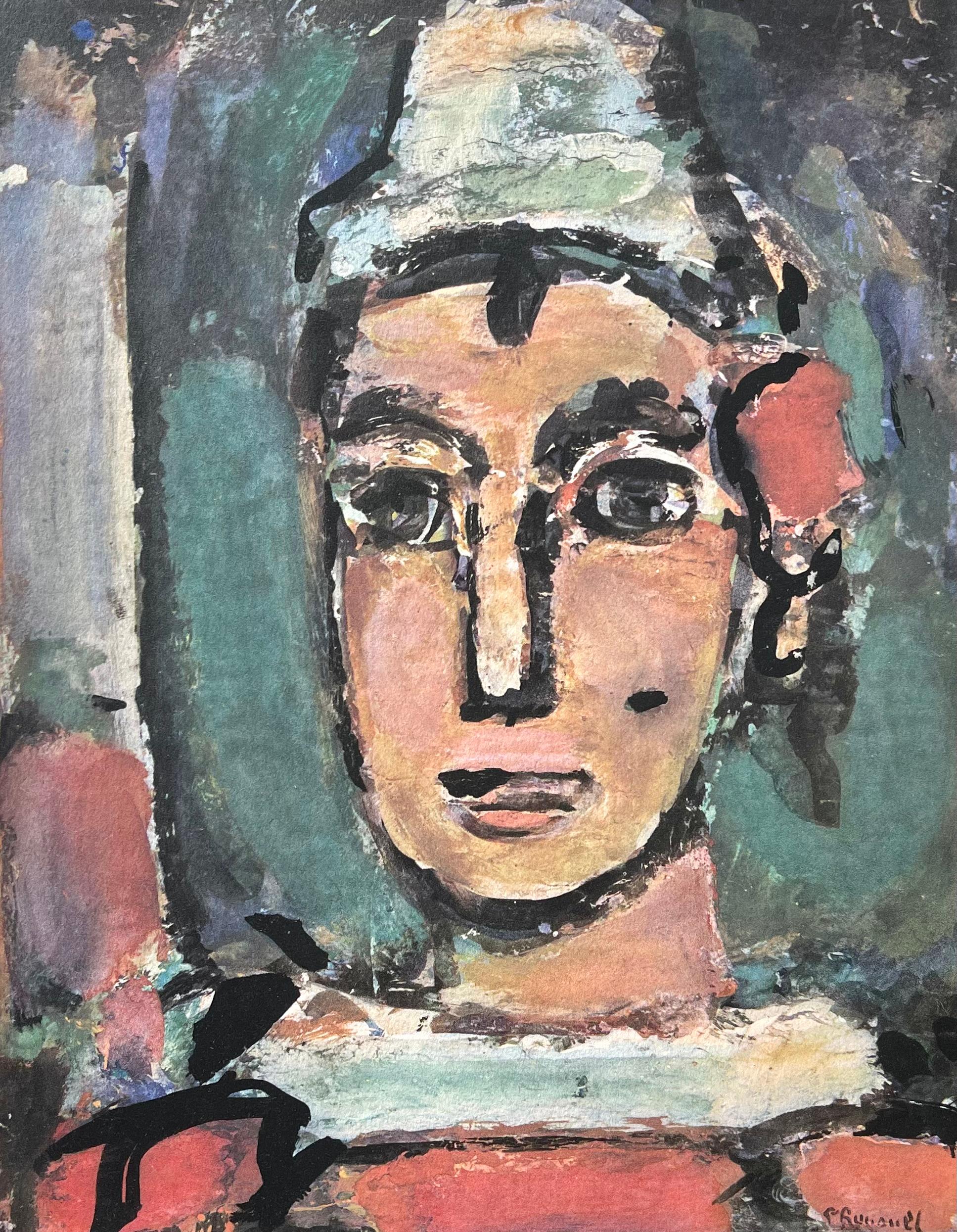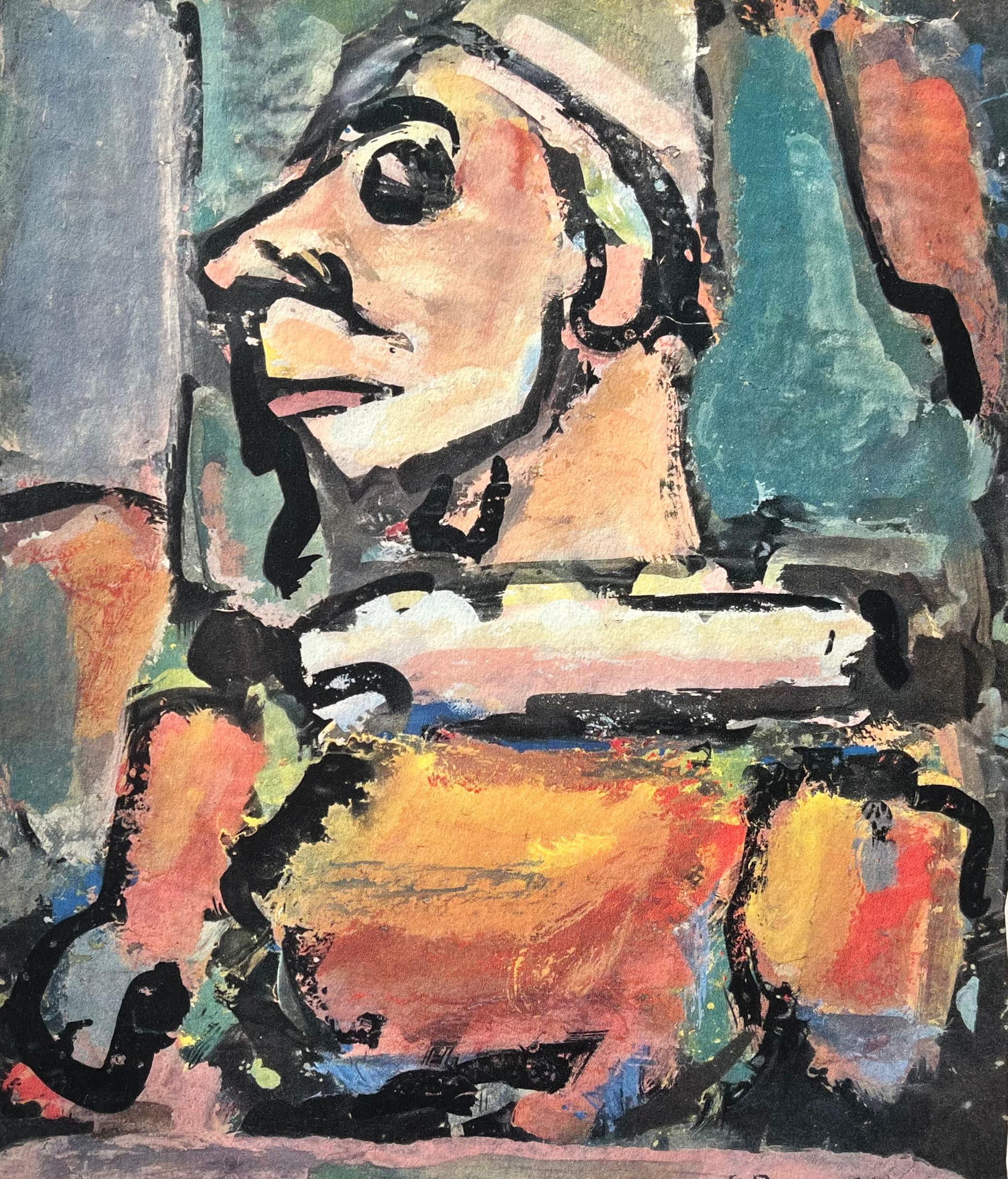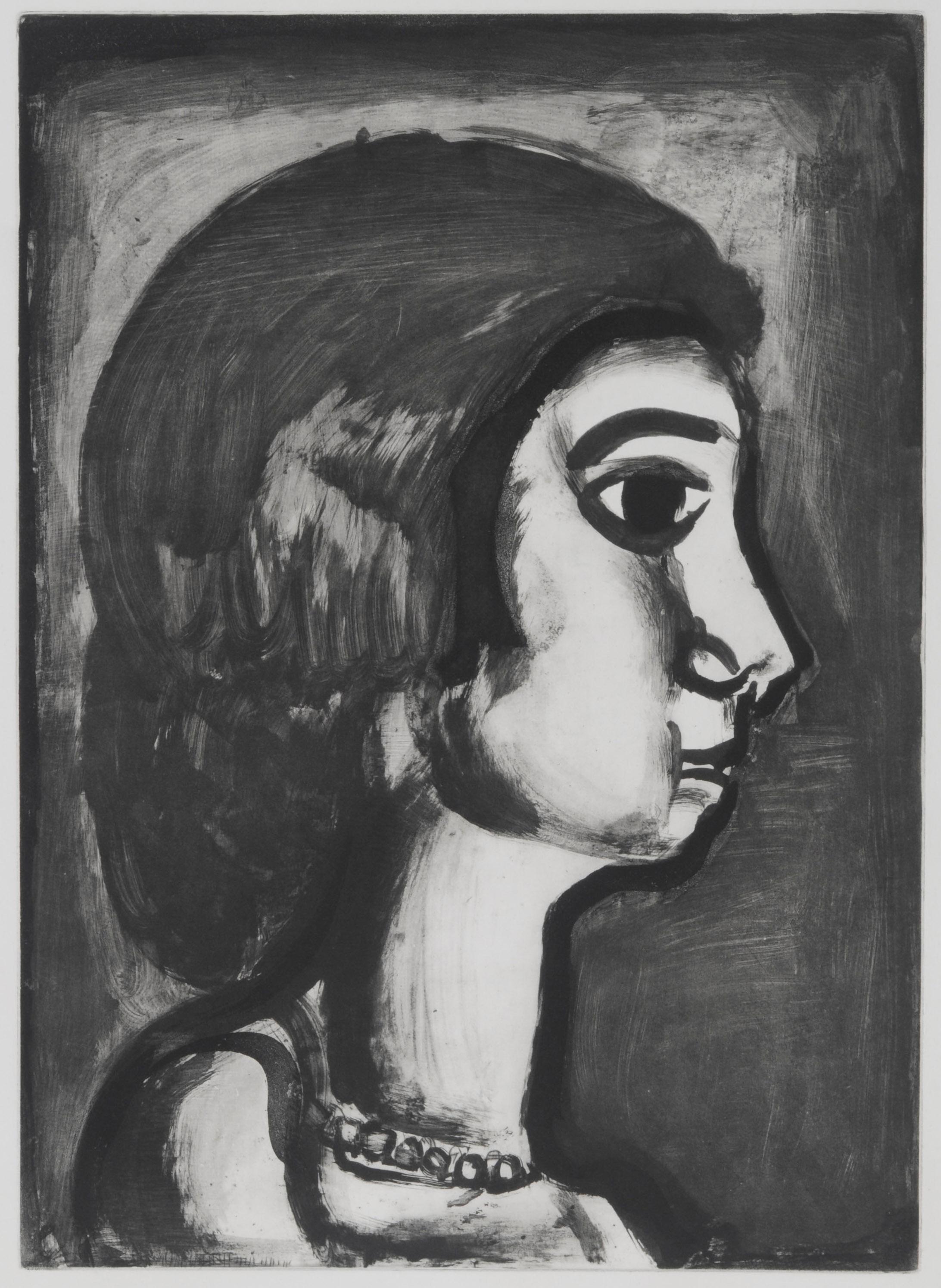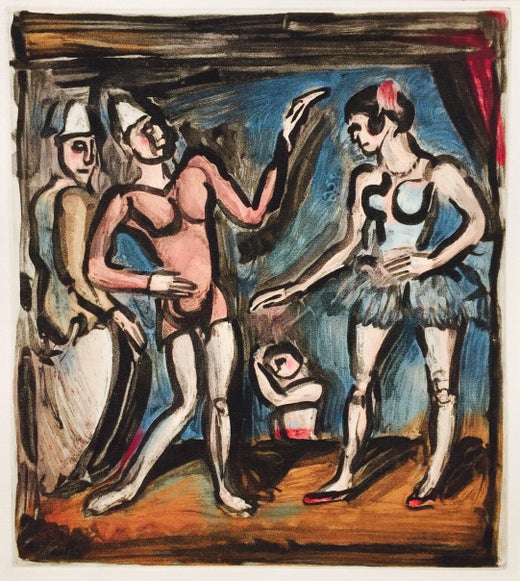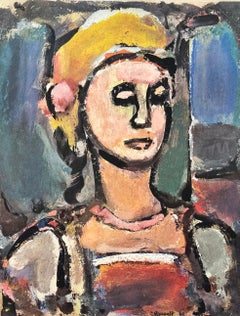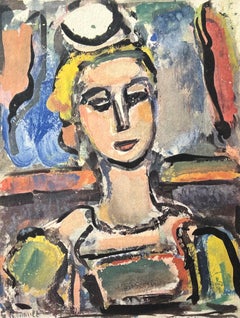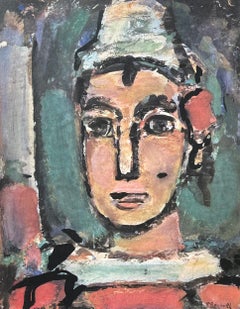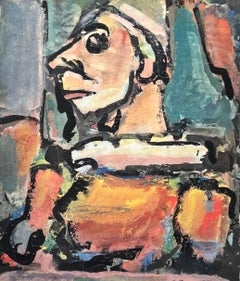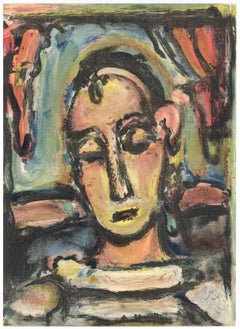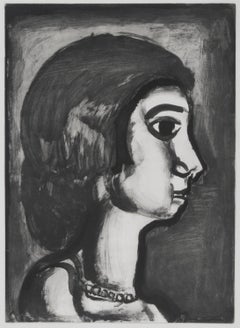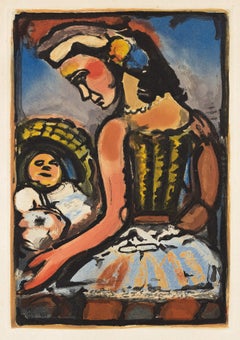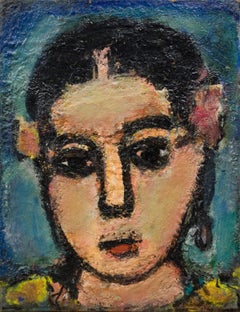Items Similar to Tête de Jeune Fille, Verve: Revue Artistique et Littéraire
Want more images or videos?
Request additional images or videos from the seller
1 of 9
Georges RouaultTête de Jeune Fille, Verve: Revue Artistique et Littéraire1939
1939
$716
$89520% Off
£540.69
£675.8720% Off
€619.05
€773.8120% Off
CA$1,011.18
CA$1,263.9720% Off
A$1,103.97
A$1,379.9620% Off
CHF 578.76
CHF 723.4520% Off
MX$13,408.09
MX$16,760.1120% Off
NOK 7,227.82
NOK 9,034.7820% Off
SEK 6,824.99
SEK 8,531.2420% Off
DKK 4,620.52
DKK 5,775.6420% Off
About the Item
Lithograph on vélin des Papeteries du Marais paper. Paper Size: 14 x 10.25 inches. Inscription: Signed in the plate and unnumbered, as issued. Notes: From the album, Verve: Revue Artistique et Littéraire, Vol. II, N° 5-6, 1939. Published by Éditions de la revue Verve, Paris, under the direction of Tériade, éditeur, Paris; printed by Mourlot Frères, Paris, 1939 in an edition of MM. Additional notes: Excerpted from Poppy Sfakianaki, ‘La revue Verve (1937–60): Un tremplin pour la carrière de Tériade dans les éditions d’art’, Journal of European Periodical Studies, 4.2 (Winter 2019), 70–89, In 1937, Tériade (1897-1983) met David Smart (1892-1952), the American publisher of Esquire magazine, who offered him to the opportunity to collaborate on the creation of 'the most beautiful magazine in the world'. Smart recognized in Tériade not only his ability as a publisher and knowledge of art history, but also his professional network and the name he made for himself in the Parisian art world—all crucial advantages for an editorial business. Having had the commercial conviction that beauty "sells", Smart intended to address the American public, attracted to French art, including Modern art, and the myth of artistic life in Paris. For his part, Tériade saw the proposed collaboration as an opportunity for a foray into the American market—a powerful ally of modern art in France. Éditions de la Revue Verve was founded in November 1937, largely funded by Smart, and directed by Tériade. Verve: Revue Artistique et Littéraire was a luxurious and ambitious art publication, published not only in French, but also in English in its early years, and distributed in Europe and the United States. Its configuration was reminiscent of that of the French art journals Cahiers d'art, Minotaure, and Arts et métiers graphiques, as well as that of the American art magazine, Coronet. However, Verve was superior to the competition because of its copious iconography and high printing quality. Its price varied between 60 and 150 francs (for double numbers) before the war, and between 120 and 350 francs during the war. Given its high price, the magazine mainly targeted art dealers, collectors, bibliophiles and wealthy art lovers. The exquisite aesthetics of the magazine was due to its editor-in-chief, Tériade, who sought to develop a platform for dialogue between image and text, visual arts and literature. The dominant factor of each issue remains its iconography, composed of reproductions of works by modern artists that Tériade admired, and 'masters', mainly of the French tradition, alongside photos and miniatures of medieval manuscripts. Tériade undoubtedly realized with his magazine an idea expressed in 1934 according to which books served as an 'ideal museum' or an exhibition where all the artistic masterpieces are gathered, which Malraux developed later in Le Musée imaginaire (Geneva: Skira, 1947), parts of which will appeared in Verve. During Second World War the periodicity of the journal changed, then irregular, and the less varied nature of the subjects treated. Thus, the issues published during the War (as well as in 1945 and 1946) were devoted exclusively to the reproduction of medieval illuminations. Finally, the special issues of the post-war period each present the recent production of a modern art painter. Only numbers 8 (1940) and 27-28 (1952) were an exception with a more varied summary. Verve's reception was positive as evidenced by several laudatory press articles throughout its run. The success of the magazine, Tériade's passion for modern art and medieval manuscripts, his admiration for the publications of Ambroise Vollard and Albert Skira, and his knowledge of the world of bibliophiles, soon led him to amplify his editorial activity. In 1943, despite the practical difficulties imposed by the war, his first artist's book was published, written and illustrated by Georges Rouault. Until 1975, Tériade published Éditions de la Revue Verve, nine books by modern artists, such as Henri Matisse, Pablo Picasso, Marc Chagall, Joan Miró, entirely composed (text and images) by the artists; seventeen books illustrated by recognized modern artists; an album of lithographs by Fernand Léger on Paris; two photographic albums by Henri Cartier-Bresson; two monographs on the artists André Beaudin and Francisco Borès; a luxurious series of reproductions of medieval illuminations; and, a series of portfolios on great French architecture. Ultimately, the comparative study of the journal and the editions of Verve: Revue Artistique et Littéraire illustrates the importance of the tacit relational dynamic that results from the relations of collaboration and exchange of symbolic capital based on common perceptions and interests, as well as on feelings of mutual friendship and appreciation of actors in the art world who share a visual and bibliophilic culture and thus contribute to the success of the journal and the publishing house.
GEORGES ROUAULT (1871-1958) French painter, printmaker, ceramicist, and maker of stained glass who, drawing inspiration from French medieval masters, united religious and secular traditions divorced since the Renaissance. Rouault was born in a cellar in Paris during a bombardment of the city by the forces opposed to the Commune. His father was a cabinetmaker. A grandfather took an interest in art and owned a collection of Honoré Daumier’s lithographs; Rouault said later that he “went first to school with Daumier.” In 1885 he enrolled in an evening course at the Paris École des Arts Décoratifs. From 1885 to 1890 he was apprenticed in a glazier’s workshop; his mature style as a painter was undoubtedly influenced by his work on the restoration of medieval stained-glass windows, including those of Chartres cathedral. In 1891 he entered the École des Beaux-Arts, where he soon became one of the favourite pupils of the Symbolist painter Gustave Moreau, in a class that also included the young Henri Matisse and Albert Marquet. After the death of Moreau in 1898, a small Paris museum was created for his pictures, and Rouault became the curator. Among the major artists of the 20th-century school of Paris, Rouault was an isolated figure in at least two respects: he practiced Expressionism, a style that has never found much favour in France, and he was chiefly a religious painter—one of the most convincing in recent centuries. Both statements, however, need qualification. Rouault was not as fiercely Expressionistic as some of his Scandinavian and German contemporaries; in some ways his work is a late flowering of 19th-century Realism and Romanticism. And he was not an official church artist; his concern with sin and redemption was deeply personal.
- Creator:Georges Rouault (1871-1958, French)
- Creation Year:1939
- Dimensions:Height: 14 in (35.56 cm)Width: 10.25 in (26.04 cm)
- Medium:
- Movement & Style:
- Period:
- Condition:
- Gallery Location:Southampton, NY
- Reference Number:1stDibs: LU1465216348102
Georges Rouault
Executed in 1937, Carlotta belongs to a group of portraits of members of society. Unlike Picasso and Toulouse-Lautrec, who portrayed these individuals with pathos, Rouault’s approach was unapologetic and raw. In the present work several layers of pigment can be discerned; the build-up of translucent and opaque layers of paint creates a three-dimensionality that characterizes the artist’s strongest work. Furthermore, the work is highlighted by the deep swaths of black delineating the subject, representing a signature element of Rouault’s portraiture of this period.
About the Seller
4.9
Platinum Seller
Premium sellers with a 4.7+ rating and 24-hour response times
Established in 1978
1stDibs seller since 2021
1,189 sales on 1stDibs
Typical response time: <1 hour
- ShippingRetrieving quote...Shipping from: Southampton, NY
- Return Policy
Authenticity Guarantee
In the unlikely event there’s an issue with an item’s authenticity, contact us within 1 year for a full refund. DetailsMoney-Back Guarantee
If your item is not as described, is damaged in transit, or does not arrive, contact us within 7 days for a full refund. Details24-Hour Cancellation
You have a 24-hour grace period in which to reconsider your purchase, with no questions asked.Vetted Professional Sellers
Our world-class sellers must adhere to strict standards for service and quality, maintaining the integrity of our listings.Price-Match Guarantee
If you find that a seller listed the same item for a lower price elsewhere, we’ll match it.Trusted Global Delivery
Our best-in-class carrier network provides specialized shipping options worldwide, including custom delivery.More From This Seller
View AllMargot, Divertissement, Éditions de la Revue Verve
By Georges Rouault
Located in Southampton, NY
Lithograph on vélin d'Arches paper, archivally mounted to a larger vélin d'Arches support sheet, as issued. Paper Size: 16 x 12.5 inches, overall; 11 x 8 inches, image. Inscription: ...
Category
1940s Modern Figurative Prints
Materials
Lithograph
$716 Sale Price
20% Off
Free Shipping
La Roussalka, Divertissement, Éditions de la Revue Verve
By Georges Rouault
Located in Southampton, NY
Lithograph on vélin d'Arches paper, archivally mounted to a larger vélin d'Arches support sheet, as issued. Paper Size: 16 x 12.5 inches, overall; 11 x 8 inches, image. Inscription: ...
Category
1940s Modern Figurative Prints
Materials
Lithograph
$716 Sale Price
20% Off
Free Shipping
Jentie Bernard, Divertissement, Éditions de la Revue Verve
By Georges Rouault
Located in Southampton, NY
Lithograph on vélin d'Arches paper, archivally mounted to a larger vélin d'Arches support sheet, as issued. Paper Size: 11 x 8 inches, image; 16 x 12.5 inches, overall. Inscription: ...
Category
1940s Modern Figurative Prints
Materials
Lithograph
$716 Sale Price
20% Off
Free Shipping
Le Moqueur, Divertissement, Éditions de la Revue Verve
By Georges Rouault
Located in Southampton, NY
Lithograph on vélin d'Arches paper, archivally mounted to a larger vélin d'Arches support sheet, as issued. Paper Size: 16 x 12.5 inches, overall; 11 x 8 inches, image. Inscription: ...
Category
1940s Modern Figurative Prints
Materials
Lithograph
$716 Sale Price
20% Off
Free Shipping
Petit Page rouge et or, Divertissement, Éditions de la Revue Verve
By Georges Rouault
Located in Southampton, NY
Lithograph on vélin d'Arches paper, archivally mounted to a larger vélin d'Arches support sheet, as issued. Paper Size: 16 x 12.5 inches, overall; 11 x 8 inches, image. Inscription: ...
Category
1940s Modern Figurative Prints
Materials
Lithograph
$716 Sale Price
20% Off
Free Shipping
Madame Yxe, Divertissement, Éditions de la Revue Verve
By Georges Rouault
Located in Southampton, NY
Lithograph on vélin d'Arches paper, archivally mounted to a larger vélin d'Arches support sheet, as issued. Paper Size: 16 x 12.5 inches, overall; 11 x 8 inches, image. Inscription: ...
Category
1940s Modern Figurative Prints
Materials
Lithograph
$716 Sale Price
20% Off
Free Shipping
You May Also Like
"Tete de jeune fille" lithograph
By (after) Georges Rouault
Located in Henderson, NV
Medium: lithograph. Printed by Mourlot and published in Paris by Teriade for Verve (Volume 1, Number 5/6), in 1939. There is another lithograph printed on the back, as published. The...
Category
1930s Prints and Multiples
Materials
Lithograph
Fille dite de joie (They Call Her Daughter of Joy)
By Georges Rouault
Located in Fairlawn, OH
Fille dite de joie (They Call Her Daughter of Joy)
Aquatint, drypoint, roulette and burnishing over heliogravure, 1922-1927
Unsigned (as issued)
From: Miserere (Have Mercy), 58 plate...
Category
1920s French School Figurative Prints
Materials
Aquatint
Dors mon amour
By Georges Rouault
Located in New York, NY
A superb impression of this color aquatint. From an unnumbered edition of 280. Printed by Lacouriere, Paris. Published by Vollard, Paris. From "Cirque de l'Étoile Filante."
Catalogu...
Category
1930s Fauvist Abstract Prints
Materials
Color, Aquatint
Carlotta
By Georges Rouault
Located in Mc Lean, VA
Literature
Dorival, Bernard & Rouault, Isabelle, Rouault, L’Oeuvre peint(Monaco, 1988), vol. 2, p. 150, no. 1864 (illus.)
Executed in 1937, Carlotta belongs to a group of portraits...
Category
1930s Post-Impressionist Figurative Paintings
Materials
Canvas, Oil
Price Upon Request
"Delphine" pochoir
By (after) Georges Rouault
Located in Henderson, NV
Medium: pochoir (after the painting) for Georges Rouault's "Visages" portfolio, printed in 1969 at the atelier of Daniel Jacomet on Chiffon de Mandeure wove paper in an edition of 45...
Category
1960s Prints and Multiples
Materials
Lithograph, Stencil
"Courtisane aux Yeux Baisses" from the suite "Les Fleurs du Mal""
By Georges Rouault
Located in San Francisco, CA
This artwork titled "Courtisane aux Yeux Baisses" from the suite "Les Fleurs du Mal" created in 1937, is an original color aquatint on Montval paper by renown French artist Georges Rouault, 1871-1958. It is signed and dated in the plate as issue. Published by Ambroise Vollard, Paris and printed by Lacouriere, Paris. Referenced and pictured in the artist's catalogue raisonnes by Chapon plate #276, Wofsy plate #273. The plate mark (image) is 11.75 x 8.15 inches, framed size is 20.5 x 17.25 inches. Custom framed in a wooden brownish and gold frame, with fabric matting and black fillet. Artwork and frame are in excellent condition, the colors are fresh and bright. Example of this artwork is held in many museums including The National Gallery of Art.
About the artist:
French painter, draughtsman, printmaker and designer, Georges Rouault created a personal style of Expressionism that gives him a highly distinctive place in Modern Art. Rouault was born in 1871, in the cellar of a house in Belleville, a working class quarter of Paris near the Père Lachaise cemetery, while the city was being bombarded by government troops quelling the Paris Commune. His father was a finisher and varnisher of pianos at a local factory. Rouault's grandfather was an amateur art...
Category
Mid-20th Century Expressionist Figurative Prints
Materials
Aquatint
More Ways To Browse
Tete De Jeune Fille
Alec Monopoly Signed
Alex Katz Sarah
Alphonse Levy
Amtrak Vintage Posters
Anatole Krasnyansky Serigraph
Andre Lambert
Andy Warhol Indian Poster
Andy Warhol Mickey Mouse
Andy Warhol Moonwalk
Angel Bracho
Antique Japanese Hair Combs
Antique Print Guatemala
Antonio Nocera
Aristocrat Watch
Arnold Herstand
Astro Boy Vintage
Aubrey Beardsley Salome
